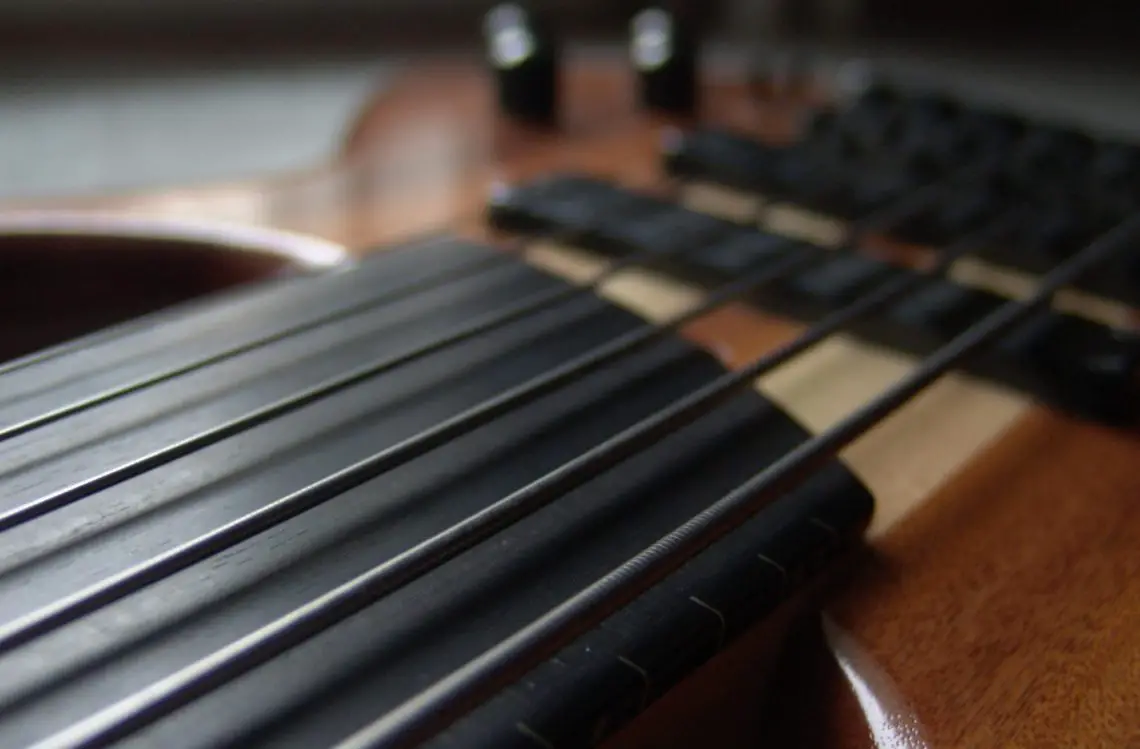
Credit: Musician’s Friend
Top Pick: Fender Tony Franklin Precision Bass
Made of high-quality wood, features the most advanced details, and packs impeccable sound
The Ibanez Five String Fretless is also a great buy for less serious players looking to add fretless sounds for an experimental element. Between these two fretless electric guitars, you can find low or high budget, serious or introductory fretless playing levels, and varying quality of materials.
Research Methods
First, I examined the market to see what was available in fretless options by each unique feature in electric bass guitars. Factors like neck attachments, bridge and pickup types, and materials all played a key role in my selections for various categories.
After assessing the major brands and most popular items, understanding the price ranges, and reading many reviews on each product’s sound quality and most common genre, I selected the best model based on an expert’s perspective.
A fretless electric bass guitar is usually something that advanced bass players pick up after years of learning the bass guitar. Therefore, the best model should be based on an advanced skill level, professional, clean tone, and moderate to high budget.
My second recommendation is based on an experimental or highly advanced user, with extra strings for an even higher range of notes.
Whether one of my top three items are right for you or not, this article will help you understand the many factors that play a part in the experience you have playing a fretless bass guitar.
Why Choose a Fretless Bass Guitar?
Fretless guitars allow you to slide between notes and scales very quickly and in a jazz like style. Because they do not have the slots that tell your fingers which scale you are playing, you must know your scales by ear to really be able to play a fretless bass guitar.
To tell if you are ready to play a fretless bass guitar, a good test is to try to tune your guitar by ear. If that is a big challenge, you can be sure that a fretless bass will be a big challenge too.
First, master the scales on a traditional electric bass guitar. Then, when you have a mature understanding of the notes, use this guide to find the perfect fretless guitar.
To see some of the first lessons and hear some of the first tasks involved in learning how to play a fretless bass, check out this video by a fretless bass player named Scott.
Anatomy of a Fretless Electric Bass Guitar
Electric bass guitars come in a wide variety based on many key features. By deciding which type of feature will be best for you in the following areas, you will be ready to select a fretless bass guitar for any genre, skill level, and budget.
The top half of the guitar includes several components: the strings; how they are attached to the guitar, called the bridge, headstock, and pickups; and the frets used to create different chords on the neck.
The Neck
On a bass guitar the long, narrow piece that the musician supports from underneath with one hand, is called the neck. Most of the necks play the major role of housing the frets, where various chords are played.
On a fretless electric bass guitar, the neck is used differently but still designed very similarly. Composing the neck are three main parts. They are the fretboard, the headstock, and the tuning keys.
The Fretboard
Fretboards lie on the top of the neck facing away from a musician, so that the tops of his fingers can slide along it. Typically, there are slots of metal to create scales, but fretless guitars are special in that they have smooth fretboards, more similar to some models of orchestra instruments like violins. This type of fretboard is meant for advanced bass players.
Typically, there are slots of metal to create scales, but fretless guitars are special in that they have smooth fretboards, more similar to some models of orchestra instruments like violins. This type of fretboard is meant for advanced bass players.
You can view an example of a fretless neck on the store website for Musician’s Friend’s. This model has pictures that you can click through to view the instrument from different angles and to give you a good idea of how it is different from a typical fretboard.
Truss Rods
One advanced feature any type of fretboard can have is called a truss rod. This is a metal bar that runs inside the fretboard and can be adjusted occasionally.
You might want a guitar with a truss rod that you can adjust every few years because bass guitar have especially tight and strong strings, creating a lot of tension on the neck and fretboard.
The fretboards can twist over time and this can impact sound and pitch. Having the option to check in on a truss rod and make sure your fretboard has remained straight is a definite advantage.
The Headstock & Tuning Keys
At the end of any bass guitar there is a block called the headstock. The headstock is where the strings feed into the top piece of the guitar and through to the metal pieces that tune the guitar, called tuning keys.
The headstock is often made of different types of materials than the rest of the guitar based on weight, style, and budget.
3 Type of Neck Attachments
The neck of the guitar attaches to the body in one of three ways. You should note that even though the strings lie on top of the neck, they attach to the body of the guitar further down, on a component called the bridge.
The neck attachment is simply where the body of the guitar begins and the neck piece with the fretboard ends.
Bolt-On
First is the bolt on neck, where the material from the neck overlap onto the body of the guitar. One advantage of this particular style is that it is simple and inexpensive.
The more the neck material overlaps onto the body, the stronger the sound will be. As long as the connection is secure, the sound quality should be strong, but some other options are even better.
Set
The second type of neck attachment is the set neck. This style uses a large piece of hardware to attach the neck to the body. The advantage is better, fuller sound quality, but the disadvantage is that these types are difficult to adjust.
Full Body
The third and best type of neck attachment is the full body neck. A full body neck uses one piece of material, usually high quality wood like mahogany to craft the neck and front and back of the body.
With no pieces to connect, fully body necks offer the cleanest, smoothest sound which is especially important in a specialty instrument like a fretless bass guitar.
All in all, investing in a solid neck and choosing one that you feel comfortable leaning and adapting to your music style is well worth the extra investment.
Scale
Even though fretless bass guitars do not have metal slots that mark different scales, they do come in three different scale lengths. These lengths do not have as much to do with the note variation as they do with the musician and fitting his or her body best.
A short scale electric guitar has a thirty inch scale, which stretches from the top of the fretboard to the bridge, where the strings end at the bottom of the guitar. The scale basically decides how far of a reach a musician must have in order to properly master it.
A regular scale guitar has a thirty four inch scale, and lastly, a long scale electric bass has a thirty five inch scale. When you choose the scale, it is most helpful to try playing each size guitar. For people who are shorter, the short scale model will be best.
The Strings
Four
Four string guitars were the first type available. They offer a solid range of notes and are ideal for bass guitar beginners. For the more advanced bass guitar player taking a swing at a fretless bass, a four string might be a good start, especially if you are most familiar with four string fretted bass guitars.
Five, Six, Seven, and Eight
On the other hand, a guitar with additional strings offers a wider range of pitches from a smaller space on the neck. You do not have to move your hands up and down on the fretboard as much to create the same sounds on a five to eight string bass as you do on a four sting bass.
However, the more strings you add on to a fretboard, the wider the board will need to be. This means you will have to reach in a different direction wider than on a four string guitar.
Also, some techniques like slap bass and tapping become exceptionally difficult on a bass guitar that has extra strings because it requires extra control.
For the most advanced electric bass players, fretless five, six, seven, and eight string guitars create impressive sound range, tone, quality, and unique effects.
The Bridge
The piece of a bass guitar where the strings feed through and attach to the bottom of the instrument is called the bridge. There are three different types of bridges, each named after the way that the strings are incorporated through it.
These three types are called the through bridge, the string-through body, and the bridge and tailpiece combination.
Although studying pictures of each will help you understand how they work, the best way to choose one style over anther is by trying out the instrument and plucking a few notes to see which type produces the feel and sound you want to achieve.
3 Types of Pickups
The last part of the top half of an electric bass guitar is called the pickup. There can be one or more pickups that pickup vibrations from the instrument and convert them into electromagnetic energy waves.
The first type is called a single cell pickup, and has only one coil and one magnet. While simpler in design, they are also sometimes noisy and not as professional sounding. The second type of pickup is the humbucker pickup, which was designed to cancel out the hum of single cell coils.
Unfortunately, by canceling out the hum, these pickups also produce a muddled sound, especially at louder volumes.
The third and final type of pickup is usually the best type because it is a hybrid between the two. Called the split coil pickup, it uses only one coil but disperses the vibrations across a wider surface area.
The bottom half of an electric bass guitar holds many of the components that create differences in sound. The electronic system, called the preamp, the body design, the materials used, and the main type of electric bass guitar all lie in the lower half of the instrument and, in the end, decipher which type of fretless electric bass will be right for your playing style.
Passive vs. Active Preamps
Passive: Passive preamps run independently without batteries, which means that they are not at risk for dying during a show or needing to be plugged in while playing. As a simpler model, passive electric bass guitars are best for beginners over active bass guitars. They also typically have 3 nobs used to create more of a low-fi sound.
Active: Active preamps run on power, unlike passive preamp bass guitars, but provice extra control for the tone and a higher output for the volume. They offer extra EQ features and can sometimes even have customizable pickups, where you can alter the wiring.
Some of the active electric bass guitar even have a switch to move from humbucking pickups to a single coil pickup.
Body Design and Material
The body of a bass guitar is one of the most widely varying components.
Hollow vs Solid
Available in two main types, a hollowbody creates a softer sound more similar to an acoustic guitar and is lighter in weight. On the other hand, a solidbody bass creates a heavier, stronger sound and has more weight to it.
The materials used to make the body of the guitar influence sound as well, but not as much as the type of body regarding hollow or solid. Materials are also used specifically to create unique styles, to offer custom effects, and to control the budget of a guitar’s production.
Wood
Wood is the most common type of material or bass guitar bodies are typically made from, varying from expensive, high quality wood to stacked or pressed wood.
Some of the most popular types include ash, specifically swamp ash, mahogany, basswood, maple, walnut, alder, and agathist. Some even more exotic types of materials are used on especially expensive or styled bass guitars.
The qualities listed above include the most important features to understand when selecting a fretless bass guitar. Electric guitars have the added component of preamps, in addition to all of the main guitar parts that exist n acoustic and electric guitars.
Hopefully now that you have a firm grasp of the different elements that you can expect to see varying on each model of guitar you check out, you will be able to understand these differences without feeling overwhelmed.
If you take your time choosing an instrument that as the best features in each category for what type of music you play or sound you want to create, buying a new fretless electric bass guitar can be an exciting way to try a new instrument after years of playing bass guitar.
4 Different Types of Electric Bass Guitars
P Bass
The first electric basses invented were P bass guitars and yet some of the most popular bass guitars on the market today are still P bass guitars. Their main advantage is their exceptional range of sound. They can reach from a high pitched, shrill sound to a deep, full sound. P bass models also have split coil humbucker pickups, giving them the advantages of both types of pickups, and therefore,
They can reach from a high pitched, shrill sound to a deep, full sound. P bass models also have split coil humbucker pickups, giving them the advantages of both types of pickups, and therefore, a impeccable sound delivery.
Jazz Bass
For a more dominant sound, jazz bass guitars offer stronger sounds when put in bands or behind other main instruments than the slightly more subtle P bass guitars. Obviously ideal for jazz music, they use two single coil pickups and offer extra control over tone through the added support.
Bass Guitar Humbuckers
If you want a thicker sound than P bass guitars and jazz bass guitars, a bass humbucker might be right for you. You can mix the volume and tone of each one of the two humbuckers to achieve a specific tone. The
The nobs offer a chance to master extra customization because the nobs require slightly higher skill level to play the full sound range.
Acoustic-Electric
Built the exactly same size as any other electric bass guitar, these smaller versions do not require an amp for sound. Size is the most obvious difference in this guitar upon first glance.
However, the ability to use it without an amp is the largest difference in sound. One advantage, then, is the ability to play right away without setting up any extra equipment.
The tone of an acoustic-electric bass guitar also differs from other electric bass guitars because they use different types of pickups, called piezo pickups.
Piezo pickups are most commonly used in acoustic guitars, with this one exception. Some of the downsides of these pickups is that they can be more prone to creating feedback and then also not working as well with pedals connected.
Acoustic- electric bass guitars are good additions to a stage that may only be played for a small part of a set or for groups that need simple set ups, take downs, and a lot of guitars.
Fretless Upright Bass Guitars
A larger model of a bass guitar that stands up on its own rather than having a musician wear it across his or her body is called an upright bass, or double bass. They offer deep, loud sounds with crisp, hollow notes.
More of an orchestra instrument, the upright bass is popular in traditional settings. With the electric upright bass guitar, you can transition from bass to fretless adding a new dimension to the sound.
This model of a fretless upright bass has an especially helpful feature for bass players who are new to fretless guitars. It has markers on the fretboard where the frets would be, to guide the musician.
The Competition
After hours of testing and research, here's the final competition.
| Instrument | Rating | Current Pricing |
|---|---|---|
Fender Tony Franklin Precision Bass | Great choice for skilled musicians because of many high quality features |  |
Breedlove Solo Electric-Acoustic Fretless Bass | Offers exceptional quality for a moderate price |
Our Recommendation: Fender Tony Franklin Precision

Credit: Musician’s Friend
After carefully researching the best brands, factoring each unique quality and each component within an electric bass, my top choice for fretless instruments is the Fender Tony Franklin Precision Bass. This bass is a great choice for skilled musicians because of many
This bass is a great choice for skilled musicians because of many high-quality features. First, there is an alder body and ebony fingerboard that will sound impeccable and last a long time if taken care of properly. It also has vintage tuning machines and yet a modern C-shaped neck. Offering a
It also has vintage tuning machines and yet a modern C-shaped neck. Offering a lean and professional tone, this guitar comes in at just under two thousand dollars but is well worth the price for a serious bass player looking to invest in a fretless electric bass guitar.
Runner Up: Ibanez Five String Fretless

Credit: Amazon.com
My second choice is what I recommend for the less serious bass player looking to add a new instrument to the mix for experimenting with new ways to add bass into your music.
With an extra string, this instrument will offer more opportunities to learn advanced skills and finger placement. Surprisingly this five string fretless electric bass guitar is only five hundred dollars, so it is not the serious investment many other electric guitars require up front.
With an extra string, this instrument will offer more opportunities to learn advanced skills and finger placement. Surprisingly this five string fretless electric bass guitar is only five hundred dollars, so it is not the serious investment many other electric guitars require up front.
Also Consider: Breedlove Solo Electric-Acoustic

Credit: Musician’s Friend
My runner-up was chosen based on the versatility that it offers. It truly is the best of most all features, and for less than nine hundred dollars, it offers exceptional quality for a moderate price.
The Breedlove Solo Electric-Acoustic Fretless Bass brings both electric and acoustic options to the fretless category of guitars. With a thirty five inch scale and piezo bridge, a wide range of tone and pitch are available, but at smaller volumes and a slightly smaller size. This instrument is made of top of the line rosewood, mahogany, and cedar, and is especially useful for smaller audiences or for practicing.
Between the upright, electric-acoustic, six-string, and traditional options, there is sure to be a fretless guitar out there for you with the perfect qualifications. If one of the items recommended above does not meet your needs, the details listed here and links provided will quickly guide you to your best option.
Famous Fretless Electric Bass Players
There have been many electric bass players in popular rock bands who have opted for the smoother, jazzier fretless electric bass guitar. Making a name for this instrument during times when the keyboard was replacing bass sounds, some of these artists took the fretless bass sounds to new genres.
Jaco Pastorius began as a drummer, but then his career took off when he began focusing on fretless bass guitars. He actually made his own first fretless guitar, taking the frets off and smoothing the material over himself.
Some regard him as the world’s greatest bass player, but unfortunately his recordings are the only way to hear him play anymore, as he was killed outside of a bar at age 35.
Les Claypool, who began his career with the metal funk band called Primus, has made the fretless bass guitar legend. He plays both a four and six string version, as well as an upright bass, depending on the group he is playing with and sound needed.
He has played alongside Bob Weir of the Grateful Dead, Trey Anistasio of Phish, and Bucket Head of Guns and Roses. Needless to say, Les Claypool, a legend himself, has brought the fretless guitar to stages with music gods from nearly every rock genre.
Percy Jones is another fretless bass player with widespread fame. He even quotes Michael Manring as being one of his main sources of inspiration. He also admits that while he tried an upright bass, he never felt happy with the sound and switched to a more traditional fretless electric guitar.
Quoting Wals to be his favorite fretless bass guitars, Percy Jones has played a fretless bass in all of the following projects:
Brand X, Soft Machine, Nova, Brian Eno, Roy Harper, Susanne Vega, Masami Tsuchiya, Elliott Sharp, Paranoise, Tunnels, Sarah Pillow, Liverpool Scene, and Big Jim Sullivan.
Needless to say, the fretless electric bass guitar has made several appearances on stage and on screen over the past several decades as great musicians like Jaco Pastorius, Les Claypool, Percy Jones, and Michal Manring expand the ways to play an electric bass.
Sources
• Leading Tone Media, LLC, (2016) Fretless Bass. Study Bass. December 11, 2016. https://www.studybass.com/gear/bass-guitar-buying-guide/fretless-bass/
• Scott’s Bass Lessons, (July 2, 2013) Fretless Bass Lessons. YouTube. December 11, 2016. https://www.youtube.com/watch?v=NKOUdzIYqT4
• Types of Basses. Musika. December 10, 2016. https://www.musikalessons.com/blog/2016/11/types-of-basses/
• Bass Guitar Buying Guide. Sweetwater. December 10, 2016. http://www.sweetwater.com/insync/bass-guitar-buying-guide/
• Bass Guitar Buying Guide. The Hub: Musicians’ Friend. December 10, 2016. http://thehub.musiciansfriend.com/bass-guitar-buying-guide/bass-guitar-buying-guide
• Leading Tone Media, LLC, (2016) Choosing between a 4-, 5-, or 6-String Bass. Study Bass. December 11, 2016. https://www.studybass.com/gear/bass-guitar-buying-guide/how-many-bass-strings/
• Jaco Pastorius, Inc. (2016) The Life of Jaco. Jaco. December 11, 2016. http://jacopastorius.com/
• (December 5, 2016) Les Claypool. Wikipedia. December 12, 2016. https://en.wikipedia.org/wiki/Les_Claypool
• Percy Jones. FretlessBass.com. December 12, 2016. http://fretlessbass.com/players/percy-jones/








Start the discussion at talk.hearthemusicplay.com